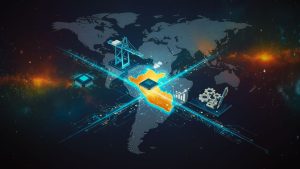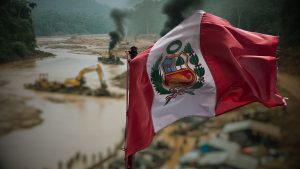Este artículo ha sido publicado inicialmente en la Revista Seguridad y Poder Terrestre
Vol. 2 N.° 2 (2023): Abril – Junio
DOI: https://doi.org/10.56221/spt.v2i2.28
Summary
China is constantly progressing to become a global leader. It is a gradual competition dating back to the 1960s, which had a favorable effect with “The New Silk Road”. This is part of a project that extends its reach to continents such as Africa, Europe, Asia and America through land and maritime trade routes that include international corridors. In Peru, the Chinese company Cosco Shipping Ports is in charge of the construction of the mega-port of Chancay, located in Huaral. The progress of this project demands that the Peruvian Government implement a strategy to address the establishment of economic and maritime exchange; it also requires ensuring other aspects that provide consistency and sustainability to national development. Therefore, this paper will present an analysis of the repercussions on South American trade and the geostrategic impact of the Chancay multipurpose port terminal.
Key words: China, International Corridors, Megaport, Strategy, National Development.
Introduction
Carl von Clausewitz,[1] military theorist of great influence in the contemporary era, stated that in order to achieve the objectives desired by a State, it is necessary that the lines of work be well defined and that all those involved in the planning process have the competencies and morale to become involved towards a common objective. In addition to this proposal, Henry Ford, father of the automobile industry and mass production, stated that “true progress is that which makes technology available to all”.[2] In other words, a true technological revolution must contribute to the development of the majority of people.
Chinese investment, since 1992, started progressively with the first purchase of an iron ore mine by the company Shuogang. By 2014, Minmetals bought Las Bambas deposit and, five years later, Cosco Shipping Ports decided to invest in the Chancay mega-port.[3] This event could be seen as the origin of a project that would turn a quiet fishing and agricultural enclave on the national coast into a multipurpose port terminal.[4]
The work began a decade ago with the corresponding procedures and feasibility studies, when the investments of the Ribaudo and Diamante fishing companies, together with the Volcán mining company (Glencore), were seeking to diversify their investments. Later, in 2019, Cosco Shipping’s investment was US$225 million, acquiring 60% of the shares and leaving Glencore with 40%.[5] It should be noted that the experience of Cosco Shipping Ports with container ships and its port vision is undeniable. The relevance of the Chancay port project is based on the fact that it will be operated and managed by China.[6] Its presence will have an impact on different levels of society, therefore requiring an analysis of the repercussions on South American trade and its geostrategic impact for the coming years.
China’s Positioning in South America
Nathan Gardels analyzes the Copernican turn that is evident these days regarding who could be the new hegemon. This in comparison to what was outlined during the Cold War. The political analyst writes that when Henry Kissinger sat down to talk with Chairman and Communist Party leader Mao Zedong, also known as Mao Tse-Tung, about the opening up of China in the 1970s, the United States was at the height of its power. Perhaps he did not consider that, less than half a century later, at 88 years of age, he would be handing over the baton of world hegemony to his hosts.[7]
Currently, the statistics, resulting from the analysis of China’s Gross Domestic Product (GDP) and trade movements, make it the country with significant economic growth in comparison with world dynamics. Bustelo explains that this sustainable growth was developed since “…the seventies and among them stand out: good starting conditions at the beginning of the reform, a privileged geographical location and a particularly successful transition strategy from central planning”.[8] In other words, China progressively organized its development and managed to expand at the right time. We can infer its interest in changing the current world order. After Mao Zedong’s death in 1979, diplomatic relations between China and the U.S. allowed for cooperation and trade practices; however, it should be noted that this economic openness deteriorated in recent years giving way to a “decoupling” that resulted in new rivalries.[9]
China, meanwhile, opted for the “peaceful rise” with the involvement of Latin America in trade and economic relations where Beijing is an investor.[10] In this context, countries such as Brazil, Chile and Peru importers of various products have found a good market in the East. Another large group is made up of Argentina, Colombia and Brazil. Thus, 21 countries have joined the “Belt and Road Initiative”, also known as the “New Silk Road”, and China has made great progress in positioning itself in South America,[11] which allows investments in bridges, ports, roads and railways around the world with the support of allies, generating strategic routes that grant commercial supremacy and global economic control, as shown in Figure 1 below.

Figure 1: China’s positioning with the “New Silk Road”.[12]
China maintains free trade agreements with Chile, Costa Rica and Peru, as well as “a joint action plan with the Community of Latin American and Caribbean States (CELAC)”.[13] China’s strategy implies a progressive advance in South America, consolidating trade relations with all countries in this hemisphere.
The Chile-Argentina-Paraguay-Brazil Bioceanic Road Corridor
On December 21, 2015, the governments of Brazil, Chile, Argentina, and Paraguay signed the “Declaration of Asunción”, the starting point of a major road project called the “Bioceanic Corridor”.[14] This project seeks to improve access to Asia-Pacific markets as an alternative to the Panama Canal. This would be achieved through a road integration of the Atlantic-Pacific through highways, linking the “Santos” port in Brazil and reaching the ports of Antofagasta, Mejillones, Tocopilla, Iquique and Arica, completed with parallel railways.[15] All this to achieve the consolidation of central tools for the corridors to find a common convergence, so that the Asia-Pacific union is strengthened in a collaborative manner.
Chile’s trade relations, including 26 bilateral and multilateral free trade agreements, allow free entry to almost all world trade, economies that represent 2/3 of the world’s population, as well as 85% of the GDP, which is very beneficial for its trade and industry.[16] In this regard, according to Jorquera, “the interest of world economic powers such as Brazil and China in these projects poses major challenges in multiple aspects, such as port infrastructure, port management and the impact on port cities”.[17] Therefore, this is an achievement that will make the economy more dynamic, increase growth opportunities for individuals and the State, which in turn will drive the initiation of new projects for the generation of industries and companies in regional production chains.
According to specialists, this project ensures the interconnection of the four countries mentioned; it will also turn them into a farm and quarry for Chinese, European and North American companies.[18] However, the lack of value-added industries among these countries could reinforce the outward-looking tendencies that have dominated this hemisphere since 1492, which would maintain the situation of dependence that, for many centuries, predominated in Latin America.
Chancay Megaport: The Shanghai of South America
The Chancay mega-port is a project located in the province of Huaral, Lima region, near the port of Callao, which is designed to decongest the existing port operations there. This Peruvian city and port would receive cargo from the east, the central highlands and even Bolivia.[19] The port of Callao currently concentrates 86.4% of the country’s port activities, although it does not have adequate roads for cargo transportation, which could be part of the risk involved in this project. However, it does have sufficient land, resources provided by the private company for the execution of the infrastructure and the coverage of the specific requirements of the design. ” The province of Huaral is expected to become the gateway to Peru from Asia and, at the same time, a hub for commercial exchange to redistribute cargo to Ecuador, Chile, and Colombia. The geopolitical impact at the local, national, and regional levels will be indisputable”.[20]
The infrastructure to be developed was designed from the conception of the recipient of mega-ships, which is why the risk is high for other nations, since it could displace them; in addition to considering the proximity to the Amazon multimodal axis, in correspondence with the “Northeast bioceanic corridor linking Brazil and Peru”,[21] making it a distribution center in the Pacific. Therefore, this port hub’s geostrategic location, having a privileged place on its way to the Asia-Pacific, will be the main international market that will attract the world’s international trade.
South American Gravitational Maritime Trade Center
The Chancay mega-port will evidence the effects of its existence in the different sectors of the economy. AthenaLab explains that having an exclusive place for the different services involved in foreign trade (customs agencies and logistics facilities) will not only provide facilities for maritime trade users, but will also contribute to port security, phytosanitary and even transnational threats from organized crime related to ports.[22]
In other words, ancillary industries and companies will find commercial opportunities. The same authors point out the requirements for the operations of modern ports that will need trained personnel; likewise, the changes coming for the investments surrounding the complex such as housing, services, and commerce will form a catalyzing system for an eminent economic progression.[23] The Peruvian government must therefore develop strategic planning aimed at strengthening the coastal ports (Paita, Bayovar, Corio and Ilo). This effort will provide strategic support to the mega-port of Chancay for the outflow of trade from all the mining and commercial corridors.
Geostrategic Impact for the Peruvian State
Peru will become China’s port hub in South America, which will upset U.S. interests, as it would undermine its ” Asian Pivot” geo-strategy.[24] According to the data: “… the Peruvian government expects to attract around 50% of the approximately US$580 million of the annual trade between China and South America”.[25] Thus, turning the mega-port of Chancay into a strategic base for the eastern country in the South Pacific, in addition to Xi Jinping’s declarations, who has set the annexation of Taiwan to China as an objective,[26] would cause a tense situation in the pursuit of commercial control of the Pacific and possible world reordering that would turn China into a future power by the year 2035.
On the other hand, there are actors who could -through defamation or corrupt practices- prevent the consolidation of the mega-project in Chancay. The detractors argue that the construction would involve environmental and social impact, due to the bulldozing of hills, excavations, handling of bulk cargo and pipelines, as well as the spaces designed for heavy vehicles and offices. It should be noted that, in 2018, “a group of civil organizations filed an appeal against the environmental impact study conducted by Cosco Shipping”.[27] The impact on the ecosystems of the Santa Rosa wetland was also denounced; coastal erosion, marine fauna, among others, was also reported.[28] These are approaches that could fuel protest actions by the population, as shown in Figure 2 below.

Figure 2: Peaceful protest march by the population of Chancay.[29]
The geopolitical influence that this project will provide to Peru will ensure a leading position in South America, which is why we will have to be attentive to the impact it will have on neighboring countries that will not want to be overshadowed by the
Peruvian growth. Hence, the political leaders in office should consider strengthening the Armed Forces in order to provide the necessary conditions to protect national interests and guarantee independence, sovereignty and territorial integrity.
Conclusions
National Strategic Planning to 2050, through the internalization of national security awareness, should ensure that the State protects its geostrategic areas and critical national assets. Thus, the Chancay mega-port shall consolidate development opportunities and invite both foreign and domestic investment. Consequently, the country will become a key hub for Asia-Pacific economic development. In this sense, the economic activities to be developed will decongest the activity of the port of Callao; furthermore, its consolidation will turn it into a hub, which is why the construction that is being carried out, with plans to complete the first dock in 2024, is designed to receive mega-ships.
On the other hand, it is necessary to mention that the bioceanic road corridor Brazil, Chile, Argentina and Paraguay, a project developed since 2015, aimed to improve access between the Asia-Pacific markets as an alternative to the Panama Canal. In this sense, the participating countries achieved a dynamism that increased their opportunities and opened up possibilities for other projects for the industry. Likewise, this construction will be the center of the South American maritime gravitational trade, a fact that will contribute to the development of the region at an economic and social level, hence it is necessary to consider all related aspects, and the Peruvian State will have new investments to catalyze the national economy. Therefore, it will be convenient to invest in improving the conditions of the coastal ports (Paita, Bayovar, Corio and Ilo) so that growth is consistent with all of them. Finally, the geostrategic impact for the State demands the implementation of an adequate national strategy for sustainable growth and development. In principle, Peru’s economic growth could generate rivalries with those who are not included in this project and would demand that those responsible have sufficient knowledge to make the right decisions. Likewise, those who can accompany this whole process are the Armed Forces, which should be adequately trained and implemented with the necessary equipment to achieve the objectives.
Endnotes:
- Carl Von Clausewitz, “De la Guerra”, 141, https://biblioteca.org.ar/libros/153741.pdf (Accessed December 4, 2022). ↑
- Guillermo D. Olmo, “Chancay, el megapuerto estratégico para el comercio con Asia que China construye en Perú (y el impacto que ya genera)”, El Observador (September 8, 2022), https://www.elobservador.com.uy/nota/chancay-el-megapuerto-estrategico-para-el-comercio-con-asia-que-china-construye-en-peru-y-el-impacto-que-ya-genera–202298942 (Accessed December 4, 2022). ↑
- Ignacio Mardones Costa, “Puerto Chancay en Perú y su impacto geopolítico en Chile- Documento de trabajo N°15”, AthenaLab (2022), 9, https://athenalab.org/wp-content/uploads/2022/03/D15-Puerto-Chancay.pdf (Accessed December 4, 2022). ↑
- Olmo, “Chancay, el megapuerto estratégico para el comercio…”. ↑
- Mardones, “Puerto Chancay en Perú y su impacto geopolítico en Chile…”. ↑
- Ibid. ↑
- Nathan Gardels, “China y el nuevo sistema mundial”, El País (July 5, 2011), 1, https://elpais.com/diario/2011/07/05/opinion/1309816804_850215.html (Accessed December 4, 2022). ↑
- Pablo Bustelo, “China en la economía mundial: fortalezas, debilidades y perspectivas” (Cuadernos de Información Económica, N°186, Fundación de las Cajas de Ahorros Funcas (2005), 74, https://www.funcas.es/wp-content/uploads/2022/04/CIE_186art8.pdf (Accessed December 4, 2022). ↑
- Germán Padinger, “China entra en una nueva era de la mano del liderazgo de Xi Jimping: ¿qué significa para el mundo y para América Latina?”, CNN Mundo (2022), https://cnnespanol.cnn.com/2022/11/10/china-xi-jinping-america-latina-orix/(Accessed December 4, 2022). ↑
- Ibid. ↑
- Ibid. ↑
- MacroALIANZA, “PELIGRO INMINENTE: Ejército de Chile teme lo peor con el Puerto de Chancay y El Tren Bioceánico”, YouTube video 27’ 14’’, (October 12, 2022), https://www.youtube.com/watch?v=mTFphAjXsHM (Accessed December 4, 2022). ↑
- Ibid. ↑
- Hernán Cortez, “Corredor Bioceánico: arteria vial de América Latina”, MAPFRE Global Risks (2021), https://www.mapfreglobalrisks.com/gerencia-riesgos-seguros/articulos/corredor-bioceanico-arteria-vial-de-america-latina/ (Accessed December 4, 2022). ↑
- Carolina Jorquera Vásquez, “Corredores bioceánico: un paso de integración”, Biblioteca del Congreso Nacional de Chile (2020), 6, https://obtienearchivo.bcn.cl/obtienearchivo?id=repositorio/10221/29347/1/N_88_20_Corredores_bioceanicos_CHILE.pdf (Accessed December 4, 2022). ↑
- Subrei, “Acuerdos de Libre Comercio”, Subsecretaría de Relaciones Económicas Internacionales (2022), https://www.subrei.gob.cl/preguntas-frecuentes/acuerdos-de-libre-comercio (Accessed December 4, 2022). ↑
- Jorquera, “Corredores bioceánico: un paso de integración”. ↑
- Cortez, “Corredor Bioceánico: arteria vial de América Latina”. ↑
- Mardones, “Puerto Chancay en Perú y su impacto geopolítico en Chile…”. ↑
- Ibid. ↑
- Ibid. ↑
- Ibid., 14 ↑
- Ibid. ↑
- Olmo, “Chancay, el megapuerto estratégico para el comercio…”. ↑
- Ibid. ↑
- ED, “Xi Jinping se marca como objetivo la anexión de Taiwán y el avance del socialismo en una nueva era para China”, El Debate (October 16, 2022), https://www.eldebate.com/internacional/20221016/comienza-xx-congreso-partido-comunista-chino-llamado-encumbrar-xi-jinping_66375.html ↑
- Olmo, “Chancay, el megapuerto estratégico para el comercio…”. ↑
- Ibid. ↑
- Coordinadora en Defensa de los Intereses de Chancay, “Impactos del puerto multipropósito terminales portuarios Chancay – Volcan”, diapositiva 33, Congreso de la República del Perú (2022), https://www.congreso.gob.pe/Docs/comisiones2016/PueblosAndinosEcologia/files/coordinadora_en_defensa_de_los_intereses_de_chancay.pdf (Accessed December 4, 2022). ↑






